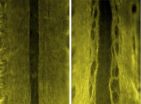(Press-News.org) Experiencing rejection not only affects how we think and feel — over the long-term it can also influence our physical and mental health. New research suggests that when rejection comes in the form of discrimination, people respond with a pattern of thoughts, behaviors, and physiological responses that may contribute to overall health disparities.
"Psychological factors, like discrimination, have been suggested as part of the causal mechanisms that explain how discrimination gets 'under the skin' to affect health," says psychological scientist and senior researcher Wendy Berry Mendes of the University of California, San Francisco. "We wanted to explore the behavioral consequences that follow experiences of discrimination to better understand these mechanisms."
Based on previous research, Mendes and her colleagues hypothesized that people would react differently depending on whether they were rejected by members of their in-group or by members of an out-group. Specifically, they predicted that people who experienced perceived discrimination — rejection from someone of another race — would show responses characteristic of approach-orientation, including anger, increased blood flow, greater vigilance, and more risk-taking behavior.
The researchers recruited 91 participants to take part in a study investigating social interactions and online communication. The participants completed an initial memory task and selected an online avatar that matched their race and sex. They provided a saliva sample and were hooked up to sensors that monitored cardiovascular activity.
The participants were told that they would be communicating with two "partners" over an online chat program, giving a speech and taking part in a discussion as the partners provided feedback via chat. In reality, the partners' responses were controlled by research assistants in another room and their feedback was adapted from a list of negative statements that the research assistants typed in real-time.
Afterward, the participants provided another saliva sample and performed cognitive tasks that measured their recall from the earlier memory test, their vigilance, and their risk-taking.
The results from the study are reported in Psychological Science, a journal of the Association for Psychological Science.
The participants who were rejected by partners of a different race (i.e., White participants rejected by Black partners, Black participants rejected by White partners) showed increased cardiac output, lower vascular resistance, and lower cortisol reactivity than participants rejected by same-race partners. They also showed more anger.
The researchers note that these findings are consistent with previous research demonstrating that anger, not shame, is the dominant emotional response following experiences of racial bias.
Participants rejected by cross-race partners also showed greater sensitivity to rewards, leading them to engage in riskier behavior on a gambling task when the potential gain was greater.
Finally, participants who experienced cross-race rejection also showed increased vigilance for emotionally negative information. While vigilance can help individuals to detect danger and respond to stressors, it can also lead to "false alarms" in which individuals detect bias in ambiguous situations. Mendes and colleagues observe that this kind of bias for emotionally negative information has been linked to anxiety and a host of clinical conditions.
As the researchers expected, same-race rejection was associated with a different pattern of physiological and cognitive responses.
Participants who were rejected by members of their own race showed greater cortisol increases, less efficient cardiac output, increased vascular resistance, and impaired memory recall — a pattern of physiological reactivity that, when experienced chronically and excessively, has been linked to accelerated "brain aging," cognitive decline, and early risk for Alzheimer's disease.
"Together, these findings suggest that while social rejection creates strong negative emotions that are manifested in changes in the brain and body, the race of the person who rejects you alters the responses to social rejection," Mendes explains.
Notably, White and Black participants responded similarly when they were rejected by cross-race partners, indicating that being on the receiving end of discrimination is painful regardless of your racial identity.
The researchers believe that these findings have broad implications. "Health care workers, epidemiologists, and others interested in understanding and combating racial health disparities may find the effects important because they offer a glimpse into the kinds of behavior that can be potentiated following an experience of discrimination," says Mendes.
Mendes and her colleagues plan to continue this line of research by examining how discrimination might influence various real-world behaviors, such as eating, sleeping, driving, and how people attend to health messages.
###Co-authors on this research include Jeremy Jamieson of the University of Rochester; Katrina Koslov of the University of California, San Francisco; and Matthew K. Nock of Harvard University.
This research was supported by funding from the National Institute on Aging (1RC2AG036780) and a seed grant from the Robert Wood Johnson Foundation.
For more information about this study, please contact: Wendy Berry Mendes at wendy.mendes@ucsf.edu.
The APS journal Psychological Science is the highest ranked empirical journal in psychology. For a copy of the article "Experiencing discrimination increases risk-taking" and access to other Psychological Science research findings, please contact Anna Mikulak at 202-293-9300 or amikulak@psychologicalscience.org.
Experiencing discrimination increases risk-taking, anger, and vigilance
2012-12-19
ELSE PRESS RELEASES FROM THIS DATE:
UC Irvine study of leaping toads reveals muscle-protecting mechanism
2012-12-19
Irvine, Calif., Dec. 19, 2012 — Most people are impressed by how a toad jumps. UC Irvine biologist Emanuel Azizi is more impressed by how one lands.
An assistant professor of ecology & evolutionary biology who specializes in muscle physiology and biomechanics, Azizi found that nature's favorite leapers possess a neuromuscular response that's specific to the intensity of a landing – a mechanism that protects muscles from injury upon impact.
The research is helping reveal how the nervous system modulates motor control patterns involved with jumping and landing. Azizi's ...
Healthy lifestyle during menopause may decrease breast cancer risk later on
2012-12-19
Obese, postmenopausal women are at greater risk for developing breast cancer and their cancers tend to be more aggressive than those in lean counterparts. A University of Colorado Cancer Center study published in the December issue of the journal Cancer Research shows how this risk might be prevented.
"By using nutrient tracers for fat and sugar, we tracked where the body stored excess calories. In lean models, excess fat and glucose were taken up by the liver, mammary and skeletal tissues. In obese models, excess fat and glucose were taken up by tumors, fueling their ...
Protein creates paths for growing nerve cells
2012-12-19
Working with mice, Johns Hopkins scientists have discovered that a particular protein helps nerve cells extend themselves along the spinal cord during mammalian development. Their results shed light on the subset of muscular dystrophies that result from mutations in the gene that holds the code for the protein, called dystroglycan, and also show how the nerve and muscle failings of the degenerative diseases are related.
As mammals like mice and humans develop, nerve cells in the brain and spinal cord must form connections with themselves and with muscles to assure proper ...
Small, portable sensors allow users to monitor exposure to pollution on their smart phones
2012-12-19
Computer scientists at the University of California, San Diego have built a small fleet of portable pollution sensors that allow users to monitor air quality in real time on their smart phones. The sensors could be particularly useful to people suffering from chronic conditions, such as asthma, who need to avoid exposure to pollutants.
CitiSense is the only air-quality monitoring system capable of delivering real-time data to users' cell phones and home computers—at any time. Data from the sensors can also be used to estimate air quality throughout the area where the ...
Host cholesterol secretion likely to influence gut microbiota
2012-12-19
For more than half a century, researchers have known that the bacteria that colonize the gastrointestinal tract of mammals influence their host's cholesterol metabolism. Now, Jens Walter and colleagues of the University of Nebraska show that changes in cholesterol metabolism induced by diet can alter the gut flora. The research was published online ahead of print in the journal Applied and Environmental Microbiology.
In the study, the researchers added plant sterol esters to the diets of hamsters. The overall effect of this was to inhibit several bacterial taxa, from ...
Tracking the origins of HIV
2012-12-19
URBANA – Human immunodeficiency virus (HIV) may have affected humans for much longer than is currently believed. Alfred Roca, an assistant professor in the College of Agricultural, Consumer and Environmental Sciences at the University of Illinois, thinks that the genomes of an isolated West African human population provide important clues about how the disease has evolved.
HIV is thought to have originated from chimpanzees in central Africa that were infected with simian immunodeficiency virus (SIV), a retrovirus. "If you look at the diversity present across SIV in chimpanzees, ...
Are we closing in on dark matter?
2012-12-19
This fall, the Kavli Institute for Cosmological Physics at the University of Chicago and the National Academy of Sciences organized a colloquium that brought together more than 100 cosmologists, particle physicists and observational astrophysicists – three fields now united in the hunt to determine what is dark matter. Their goal: to take stock of the latest theories and findings about dark matter, assess just how close we are to detecting it and spark cross-disciplinary discussions and collaborations aimed at resolving the dark matter puzzle.
So where do things stand? ...
MRIs reveal signs of brain injuries not seen in CT scans, UCSF/SFGH researchers report
2012-12-19
Hospital MRIs may be better at predicting long-term outcomes for people with mild traumatic brain injuries than CT scans, the standard technique for evaluating such injuries in the emergency room, according to a clinical trial led by researchers at the University of California, San Francisco (UCSF) and the San Francisco General Hospital and Trauma Center (SFGH).
Published this month in the journal Annals of Neurology, the study was led by UCSF neuroradiologist Esther Yuh, MD, PhD and followed 135 people treated for mild traumatic brain injuries over the past two years ...
Penn metamaterials experts show a way to reduce electrons' effective mass to nearly 0
2012-12-19
PHILADELPHIA — The field of metamaterials involves augmenting materials with specially designed patterns, enabling those materials to manipulate electromagnetic waves and fields in previously impossible ways. Now, researchers from the University of Pennsylvania have come up with a theory for moving this phenomenon onto the quantum scale, laying out blueprints for materials where electrons have nearly zero effective mass.
Such materials could make for faster circuits with novel properties.
The work was conducted by Nader Engheta, the H. Nedwill Ramsey Professor of Electrical ...
Ozone levels have sizeable impact on worker productivity
2012-12-19
December 18, 2012 -- Researchers in the Department of Health Policy and Management at Columbia's Mailman School of Public Health assessed the impact of pollution on agricultural worker productivity using daily variations in ozone levels. Their results show that ozone, even at levels below current air-quality standards in most parts of the world, has significant negative impacts on worker productivity. Their findings suggest that environmental protection is important for promoting economic growth and investing in human capital in contrast to its common portrayal as a tax ...

